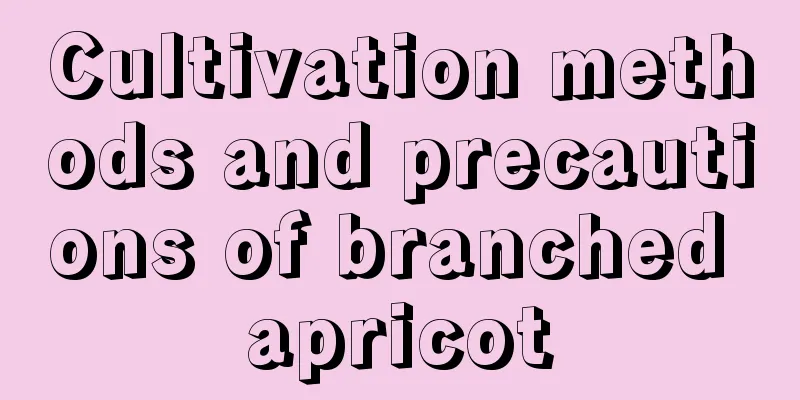Cultivation methods and precautions of branched apricot

1. Maintenance methods1. Temperature: It is suitable for growing in mild places, and the temperature should normally be maintained between 15 and 25 degrees. If the ambient temperature in winter is too low, frostbite is likely to occur, so the temperature needs to be above 10 degrees in winter. 2. Watering: The soil must have a certain amount of moisture, but water accumulation should not occur during the watering process. Flooding will cause root rot of the plant. At the same time, the number of watering needs to be determined according to the condition of the plant. If the branches and leaves of the plant are relatively full, there is no need to water it. You can continue to add water when the branches and leaves of the plant are shriveled. 3. Light: It needs to receive warm and sufficient light. It cannot be exposed to direct sunlight in summer. In winter, it needs to be placed in a place with mild sunlight, so that the color of the plant will become greener. 4. Fertilization: During the growth period, you can replenish nutrients in time and apply some foliar fertilizer. At the same time, you can dilute the fertilizer before applying it. If the fertilizer is too heavy, it can easily burn the plant. 2. Breeding techniques1. Reproduction: Sowing and cuttings are two important methods of reproduction. When cuttings, choose tender branches about ten centimeters long and then insert them directly into the soil. They will germinate in about twenty days. When sowing, be careful not to place the seeds too close together, otherwise the plants will not be strong when they grow out. 2. Pruning: It may grow too tall during its growth period, so it needs to be pruned to ensure normal growth and plant shape. At the same time, some yellowing and withered branches and leaves should also be pruned. 3. Problem diagnosis and treatment1. Disease: Soft rot may occur, which can be controlled and prevented by spraying carbendazim solution. 2. Pests: Nematodes will appear when too much fertilizer is applied, which will seriously harm the roots of the plant. They can be eliminated by repotting. IV. Other issues1. Toxicity: It is not poisonous. Many people raise it for its ornamental value. 2. Can it be grown at home? Yes, because this plant is cute in appearance and highly ornamental. |
>>: Cultivation methods and precautions of purple leaf sorrel
Recommend
Does trumpet creeper prefer shade or sun?
Does trumpet creeper prefer shade or sun? Trumpet...
Yew cultivation methods and precautions
1. Maintenance methods 1. Temperature: It has ver...
Eight flowers that bloom throughout the winter
1. Camellia potted plants People who are familiar...
When is the right time to sow radish?
Radish sowing time Radish is a plant of the genus...
What are the effects and functions of May tea
Strengthen the spleen and promote the production ...
How to propagate Desert Rose
1. Cutting method When taking cuttings for Desert...
What does sending gardenias mean?
1. Eternal Love Gardenia has a flower language, w...
Things to note when repotting the feather calathea
Things to note when repotting the feather calathe...
What is Aloe Vera
1. Species It is an evergreen, succulent herb of ...
What to do if the leaves of the rubber tree turn yellow and fall off
1. Proper shade Reason: Rubber trees are afraid o...
If you water like this, it would be strange if the flowers died.
How to judge whether it is time to water? look Ch...
What to do if the grass jade dew grows too long
1. Increase lighting Generally speaking, when pla...
Where is soybean suitable for planting?
Soybean growing area Soybeans generally grow in t...
Is hydrangea harmful to pregnant women? Is it the same as hydrangea?
1. Is it harmful? Hydrangea is harmful to pregnan...
Goldfish Chlorophytum cutting method and precautions How to achieve a high survival rate of cuttings
When the goldfish spider plant is in full bloom, ...









